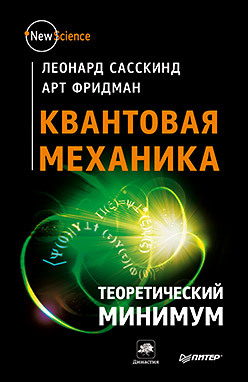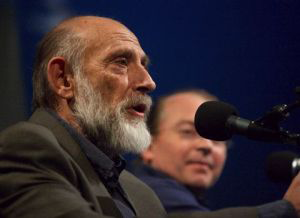Quantum mechanics. Theoretical minimum
Leonard Susskind’s 3rd book was published in our publishing house:

Prototype: Quantum Mechanics: The Theoretical Minimum
')
Classical mechanics is intuitive: it is daily and repeatedly used by people for survival. But until the twentieth century, no one ever used quantum mechanics. She describes things so small that they completely fall out of the human perception of the senses. The only way to understand this theory, to enjoy its beauty, is to block our intuition with abstract mathematics. Leonard Susskind - the famous American scientist - invites you to go on an exciting journey to the country of quantum mechanics. On the way you will benefit from basic knowledge from the school course of physics, as well as the basics of mathematical analysis and linear algebra. You also need to know something about the issues that were addressed in the first book of the "theoretical minimum" of Susskind - "Everything you need to know about modern physics." But it's okay if this knowledge is somewhat forgotten. Much of the author will remind and explain along the way. Quantum mechanics is an unusual theory: according to its postulates, for example, we can know everything about the system and nothing about its individual parts. Einstein and Niels Bohr argued a lot about this and other contradictions. If you are not afraid of difficulties, have an inquisitive mind, are technically literate, sincerely and deeply interested in physics, then you will like this course of lectures by Leonard Susskind. The book focuses on the logical principles of quantum theory and aims not to smooth out the paradox of quantum logic, but to pull it out into the daylight and try to deal with the difficult questions that it raises.
Usually we first study classical mechanics, and then we approach quantum. However, quantum physics is much more fundamental than classical physics. As far as we know, quantum physics gives an accurate description of all physical systems, but some subjects are massive enough to allow classical ones to be used with good accuracy instead of quantum mechanics. Approximation is all that is classical mechanics. From a logical point of view, we should first study quantum mechanics, but very few physics teachers recommend doing so. Even this course of lectures - “Theoretical minimum” - begins with classical mechanics. Nevertheless, classical mechanics will play almost no role in this course of lectures on quantum theory, except for the very end of the course, when all the basic principles of quantum mechanics have already been explained. I believe that this is a truly correct way to learn - not only logically, but also pedagogically. In this way, we do not fall into the trap, where it seems that quantum mechanics is, in fact, the same classical mechanics with the addition of a couple of new tricks. By the way, technically quantum mechanics is much simpler than classical.
The simplest classical system is the basic logical element of modern computer science: a two-state system. Sometimes we call it a bit . It can be something that can only be in two states: a coin, which can lie eagle or tail, a toggle switch, which can be turned on or off, a tiny magnet, which can be oriented to the north or south. As you might expect, especially if you got acquainted with the lectures of volume I , the theory of classical systems with two states is extremely simple, in fact, even boring. In this volume, we begin with a quantum version of a two-state system called a qubit , which is much more interesting. To understand it, we need a completely new way of thinking - a new foundation of logic.
Leonard Susskind (Leonard Susskind) is an American theoretical physicist, one of the founders of string theory, who now teaches at Stanford University.

He graduated from New York City College with a Master of Science degree in Physics in 1962, and received his Ph.D. in 1965 from Cornell University. Since 1979, Susskind is a professor of physics at Stanford University. In 1998, he was awarded the Sakurai Prize for innovative achievements in the field of hadron string models, lattice gauge theories, quantum chromodynamics, and dynamic symmetry breaking. Since 1999, Professor at the Korean Institute for Advanced Study.
Susskind made a significant contribution to the development of modern physics. Among his scientific achievements:
Alexander Sergeev , a famous Russian scientific journalist and popularizer of science, worked on the Russian translation of Quantum Mechanics: The Theoretical Minimum . Alexander worked for many years as a scientific editor and columnist in such publications as Vedomosti, Around the World, Radio Liberty, Science in Focus, and has authored a large number of publications and translator of several popular science books. At the moment, Alexander is conducting a cycle of programs called “The World of Science” , which is aired on Mir TV channel.
Book on the publisher site
Table of contents
Excerpt
For Habra, a 25% discount on the book and the entire “New Science” series on the Susskind coupon.

Prototype: Quantum Mechanics: The Theoretical Minimum
')
Classical mechanics is intuitive: it is daily and repeatedly used by people for survival. But until the twentieth century, no one ever used quantum mechanics. She describes things so small that they completely fall out of the human perception of the senses. The only way to understand this theory, to enjoy its beauty, is to block our intuition with abstract mathematics. Leonard Susskind - the famous American scientist - invites you to go on an exciting journey to the country of quantum mechanics. On the way you will benefit from basic knowledge from the school course of physics, as well as the basics of mathematical analysis and linear algebra. You also need to know something about the issues that were addressed in the first book of the "theoretical minimum" of Susskind - "Everything you need to know about modern physics." But it's okay if this knowledge is somewhat forgotten. Much of the author will remind and explain along the way. Quantum mechanics is an unusual theory: according to its postulates, for example, we can know everything about the system and nothing about its individual parts. Einstein and Niels Bohr argued a lot about this and other contradictions. If you are not afraid of difficulties, have an inquisitive mind, are technically literate, sincerely and deeply interested in physics, then you will like this course of lectures by Leonard Susskind. The book focuses on the logical principles of quantum theory and aims not to smooth out the paradox of quantum logic, but to pull it out into the daylight and try to deal with the difficult questions that it raises.
Introduction:
Usually we first study classical mechanics, and then we approach quantum. However, quantum physics is much more fundamental than classical physics. As far as we know, quantum physics gives an accurate description of all physical systems, but some subjects are massive enough to allow classical ones to be used with good accuracy instead of quantum mechanics. Approximation is all that is classical mechanics. From a logical point of view, we should first study quantum mechanics, but very few physics teachers recommend doing so. Even this course of lectures - “Theoretical minimum” - begins with classical mechanics. Nevertheless, classical mechanics will play almost no role in this course of lectures on quantum theory, except for the very end of the course, when all the basic principles of quantum mechanics have already been explained. I believe that this is a truly correct way to learn - not only logically, but also pedagogically. In this way, we do not fall into the trap, where it seems that quantum mechanics is, in fact, the same classical mechanics with the addition of a couple of new tricks. By the way, technically quantum mechanics is much simpler than classical.
The simplest classical system is the basic logical element of modern computer science: a two-state system. Sometimes we call it a bit . It can be something that can only be in two states: a coin, which can lie eagle or tail, a toggle switch, which can be turned on or off, a tiny magnet, which can be oriented to the north or south. As you might expect, especially if you got acquainted with the lectures of volume I , the theory of classical systems with two states is extremely simple, in fact, even boring. In this volume, we begin with a quantum version of a two-state system called a qubit , which is much more interesting. To understand it, we need a completely new way of thinking - a new foundation of logic.
About the author of the book
Leonard Susskind (Leonard Susskind) is an American theoretical physicist, one of the founders of string theory, who now teaches at Stanford University.

He graduated from New York City College with a Master of Science degree in Physics in 1962, and received his Ph.D. in 1965 from Cornell University. Since 1979, Susskind is a professor of physics at Stanford University. In 1998, he was awarded the Sakurai Prize for innovative achievements in the field of hadron string models, lattice gauge theories, quantum chromodynamics, and dynamic symmetry breaking. Since 1999, Professor at the Korean Institute for Advanced Study.
Susskind made a significant contribution to the development of modern physics. Among his scientific achievements:
- an introduction to the hadron physics of a one-dimensional fundamental object - a string;
- contribution to the theory of quark confinement;
- development of gauge theory in terms of the Hamiltonian grid;
- contribution to the string description of black hole entropy;
- development of a matrix description of M-theory;
- contribution to the development of the holographic principle.
About the translator and scientific editor of the Russian edition
Alexander Sergeev , a famous Russian scientific journalist and popularizer of science, worked on the Russian translation of Quantum Mechanics: The Theoretical Minimum . Alexander worked for many years as a scientific editor and columnist in such publications as Vedomosti, Around the World, Radio Liberty, Science in Focus, and has authored a large number of publications and translator of several popular science books. At the moment, Alexander is conducting a cycle of programs called “The World of Science” , which is aired on Mir TV channel.
Book on the publisher site
Table of contents
Excerpt
For Habra, a 25% discount on the book and the entire “New Science” series on the Susskind coupon.
Source: https://habr.com/ru/post/247787/
All Articles